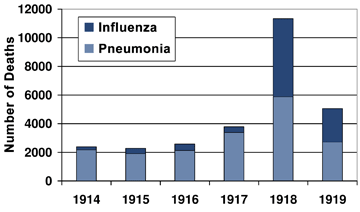1918 Flu Outbreak
In the twentieth century, major pandemics occurred in 1918-1919, 1957-1958, and 1968-1969. The 1918-1919 pandemic was the most destructive in recorded history. It started as World War I (1914-1918) was ending and caused from 20 million to 50 million deaths - two to five times as many deaths as the war itself.
When and where the pandemic began is uncertain, but because Spain experienced the first major outbreak, the disease came to be called the Spanish flu. The virus was exceptionally lethal. Many of the deaths were among young adults age 20 to 40, a group usually not severely affected by influenza.
In the United States, the first reported cases surfaced at an Army camp in Kansas as World War I began winding down. In Alabama, the first cases were reported in Huntsville. The virus quickly spread and paralyzed many communities as it circled the world.
If a pandemic were to hit the country today, mild projections predict 200,000 Americans and 4,000 Alabamians would die while severe estimates put the death toll at 1.9 million Americans and 29,000 Alabamians.
While medical technology has come a long way in the nearly 90 years since the first flu pandemic of the 20th century, reactions to another pandemic wouldn’t be much different in 2007 than they were in 1918.
Alabama Influenza and Pneumonia Deaths (1914-1919)

Source: Annual Report of the State Board of Health, 1919.
The Alabama Department of Public Health is offering a glimpse at the forgotten history of one of the world's worst pandemics. Learn more about the devastating events that occurred in Alabama during the 1918 pandemic flu outbreak from the information below.
Page last updated: May 13, 2021




